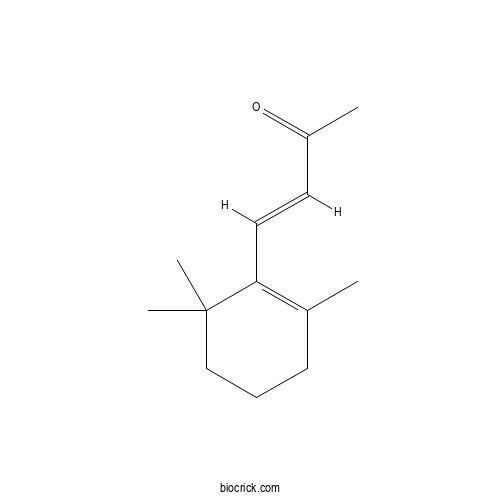4-(2,6,6-Trimethyl-1-cyclohexenyl)-3-buten-2-oneCAS# 79-77-6 |

Quality Control & MSDS
3D structure
Package In Stock
Number of papers citing our products

| Cas No. | 79-77-6 | SDF | Download SDF |
| PubChem ID | 638014 | Appearance | Oil |
| Formula | C13H20O | M.Wt | 192.3 |
| Type of Compound | Miscellaneous | Storage | Desiccate at -20°C |
| Solubility | Soluble in Chloroform,Dichloromethane,Ethyl Acetate,DMSO,Acetone,etc. | ||
| Chemical Name | (E)-4-(2,6,6-trimethylcyclohexen-1-yl)but-3-en-2-one | ||
| SMILES | CC1=C(C(CCC1)(C)C)C=CC(=O)C | ||
| Standard InChIKey | PSQYTAPXSHCGMF-BQYQJAHWSA-N | ||
| Standard InChI | InChI=1S/C13H20O/c1-10-6-5-9-13(3,4)12(10)8-7-11(2)14/h7-8H,5-6,9H2,1-4H3/b8-7+ | ||
| General tips | For obtaining a higher solubility , please warm the tube at 37 ℃ and shake it in the ultrasonic bath for a while.Stock solution can be stored below -20℃ for several months. We recommend that you prepare and use the solution on the same day. However, if the test schedule requires, the stock solutions can be prepared in advance, and the stock solution must be sealed and stored below -20℃. In general, the stock solution can be kept for several months. Before use, we recommend that you leave the vial at room temperature for at least an hour before opening it. |
||
| About Packaging | 1. The packaging of the product may be reversed during transportation, cause the high purity compounds to adhere to the neck or cap of the vial.Take the vail out of its packaging and shake gently until the compounds fall to the bottom of the vial. 2. For liquid products, please centrifuge at 500xg to gather the liquid to the bottom of the vial. 3. Try to avoid loss or contamination during the experiment. |
||
| Shipping Condition | Packaging according to customer requirements(5mg, 10mg, 20mg and more). Ship via FedEx, DHL, UPS, EMS or other couriers with RT, or blue ice upon request. | ||
| Description | Reference standards. | |||||

4-(2,6,6-Trimethyl-1-cyclohexenyl)-3-buten-2-one Dilution Calculator

4-(2,6,6-Trimethyl-1-cyclohexenyl)-3-buten-2-one Molarity Calculator
| 1 mg | 5 mg | 10 mg | 20 mg | 25 mg | |
| 1 mM | 5.2002 mL | 26.001 mL | 52.0021 mL | 104.0042 mL | 130.0052 mL |
| 5 mM | 1.04 mL | 5.2002 mL | 10.4004 mL | 20.8008 mL | 26.001 mL |
| 10 mM | 0.52 mL | 2.6001 mL | 5.2002 mL | 10.4004 mL | 13.0005 mL |
| 50 mM | 0.104 mL | 0.52 mL | 1.04 mL | 2.0801 mL | 2.6001 mL |
| 100 mM | 0.052 mL | 0.26 mL | 0.52 mL | 1.04 mL | 1.3001 mL |
| * Note: If you are in the process of experiment, it's necessary to make the dilution ratios of the samples. The dilution data above is only for reference. Normally, it's can get a better solubility within lower of Concentrations. | |||||

Calcutta University

University of Minnesota

University of Maryland School of Medicine

University of Illinois at Chicago

The Ohio State University

University of Zurich

Harvard University

Colorado State University

Auburn University

Yale University

Worcester Polytechnic Institute

Washington State University

Stanford University

University of Leipzig

Universidade da Beira Interior

The Institute of Cancer Research

Heidelberg University

University of Amsterdam

University of Auckland

TsingHua University

The University of Michigan

Miami University

DRURY University

Jilin University

Fudan University

Wuhan University

Sun Yat-sen University

Universite de Paris

Deemed University

Auckland University

The University of Tokyo

Korea University
- Artanomaloide
Catalog No.:BCN9728
CAS No.:112823-41-3
- Phyllanthurinolactone
Catalog No.:BCN9727
CAS No.:168180-12-9
- Pumiloside
Catalog No.:BCN9726
CAS No.:126722-26-7
- Rossicaside B
Catalog No.:BCN9725
CAS No.:80458-55-5
- Stephodeline
Catalog No.:BCN9724
CAS No.:56596-12-4
- O-Methylmurrayamine A
Catalog No.:BCN9723
CAS No.:134779-20-7
- N-Methoxy-3-formylcarbazole
Catalog No.:BCN9722
CAS No.:117592-01-5
- N-Methoxy-3-hydroxymethylcarbazole
Catalog No.:BCN9721
CAS No.:142768-49-8
- Yukocitrine
Catalog No.:BCN9720
CAS No.:145940-32-5
- Adenostemmoic acid D
Catalog No.:BCN9719
CAS No.:130217-20-8
- Hortiamide
Catalog No.:BCN9718
CAS No.:106055-13-4
- Adenostemmoic acid B
Catalog No.:BCN9717
CAS No.:130217-16-2
- 11-Oxomogroside IIIE
Catalog No.:BCN9730
CAS No.:2096516-68-4
- Rauhimbine
Catalog No.:BCN9731
CAS No.:66634-44-4
- Carvacryl acetate
Catalog No.:BCN9732
CAS No.:6380-28-5
- Furfuryl alcohol
Catalog No.:BCN9733
CAS No.:98-00-0
- gamma-Nonanolactone
Catalog No.:BCN9734
CAS No.:104-61-0
- 1-(3',5'-dimethoxy)phenyl-2-[4''-O-beta-D-glucopyranosyl (6->1)-O-alpha-L-rhamnopyranosyl]phenylethane
Catalog No.:BCN9735
CAS No.:1338076-61-1
- Tripalmitin
Catalog No.:BCN9736
CAS No.:555-44-2
- Capsanthin
Catalog No.:BCN9737
CAS No.:465-42-9
- Uzarin
Catalog No.:BCN9738
CAS No.:20231-81-6
- Ethyl 3-hydroxybenzoate
Catalog No.:BCN9739
CAS No.:7781-98-8
- Clausine E
Catalog No.:BCN9740
CAS No.:182261-83-2
- Quercetin 3,4'-diglucoside
Catalog No.:BCN9741
CAS No.:29125-80-2
Inhibitory Potential of Constituents from Osmanthus fragrans and Structural Analogues Against Advanced Glycation End Products, alpha-Amylase, alpha-Glucosidase, and Oxidative Stress.[Pubmed:28361983]
Sci Rep. 2017 Mar 31;7:45746.
Inhibition of alpha-amylase and alpha-glucosidase, advanced glycation end products (AGEs) formation, and oxidative stress by isolated active constituents of Osmanthus fragrans flowers (9,12-octadecadienoic acid and 4-(2,6,6-Trimethyl-1-cyclohexenyl)-3-buten-2-one) and their structural analogues were evaluated. 9,12-Octadecadienoic acid was 10.02 and 22.21 times more active against alpha-amylase and alpha-glucosidase, respectively, than acarbose and ascorbic acid, followed by 9,12,15-octadecatrienoic acid, 9-octadecenoic acid, 4-(2,6,6-Trimethyl-1-cyclohexenyl)-3-buten-2-one, 4-(2,6,6-trimethyl-2-cyclohexenyl)-3-buten-2-one, 1-heptadecanecarboxylic acid, and 1-pentadecanecarboxylic acid. Concerning the inhibition of AGEs formation, similar with data for 2,2'-diphenyl-1-picrylhydrazl radical scavenging activities, 9,12-octadecadienoic acid was 3.54 times more active than aminoguanidine, followed by 9,12,15-octadecatrienoic acid, and 9-octadecenoic acid. These results indicate that 4-(2,6,6-Trimethyl-1-cyclohexenyl)-3-buten-2-one, 9,12-octadecadienoic acid and their analogues inhibit alpha-amylase and alpha-glucosidase, AGEs formation, and oxidative stress have potential value in alleviating diabetic pathological conditions.


